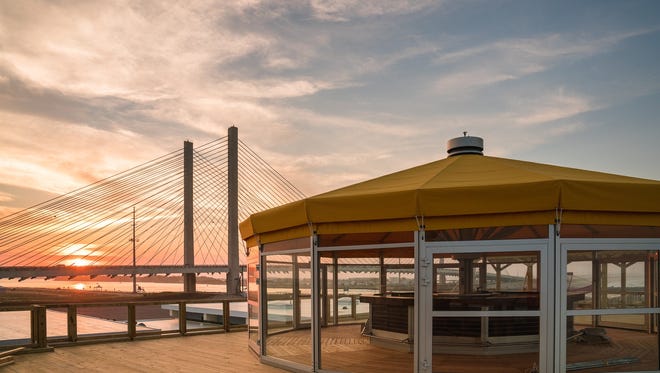Delaware parks see increase in campers thanks to upgrades
 Maddy Lauria
Maddy Lauria
One of the first things Shannon Yarnall does after returning home from the family’s annual camping trip at Delaware Seashore State Park in Rehoboth Beach is to book next year’s stay.
That’s because she knows if she waits too long, there will be no spots left.
“Most of the camp sites are filled up when we come,” she said. “We have beautiful beaches in Delaware. The secret’s out.”
The reason Yarnall books in advance, and why some people may have a hard time finding a last-minute camping spot, is because Delaware state parks are seeing a record number of overnight stays.
More than 16,500 additional campers stayed overnight at camp sites, cabins and cottages throughout the state in 2017 – a 19 percent increase from 2016, according to officials with the Department of Natural Resources and Environmental Control’s Division of Parks and Recreation.
“These numbers show that our award-winning state parks system provides high-quality experiences that all Delawareans can enjoy,” DNREC Secretary Shawn M. Garvin said in a press release. “More than five million visitors come to our state parks, which boosts our tourism economy tremendously. Our state parks staff, volunteers and concessionaires do an outstanding job providing top-notch campgrounds, educational programs, trails, historic sites, and outdoor recreation opportunities. These new figures bear that out.”
STORY:Delaware leaders mount offensive to stop offshore drilling plan
In the last five years, overnight stays have nearly doubled, growing from 67,453 visitors in 2011 to 104,469 in 2017. On average, Delaware’s 16 state parks see about 5 million visitors annually, said Delaware State Parks Director Ray Bivens.
“Last year, when we opened Big Chill [in Delaware Seashore State Park], we filled that parking lot on a Tuesday and a Wednesday. Usually that’s a weekend thing,” Bivens said. “We’re seeing that cross of day use, overnight stays and trails is more popular than ever.
“We used to think of Memorial Day to Labor Day as our busy season, but there were weekends in late April and May where you couldn’t even get a campground,” he said. “Now that things are getting tougher to get, people are planning further out.”
An increase in visitors to Delaware parks may in part be due to more $11 million in state investments to improve and renovate campgrounds over the last two years, including additional cabins at Cape Henlopen State Park in Lewes and a $5 million investment in Lums Pond State Park in Bear to bring full hook-up sites and new bathrooms for campers.
Many of the park campgrounds date back to the 1960s and 1970s and visitors were asking for those updates through online surveys, Bivens said.
“People are buying these RVs equipped with bells and whistles, and we’re modernizing to keep up with that,” he said. “There’s still people that like to tent camp, but even they like electric to charge their phones. It’s just adapting and keeping up.”
Yarnall said those amenities are key when her family is choosing where to camp. The West Grove, Pennsylvania, family has an RV and two small children, so electricity and plumbing are two must-haves.
“Last year we tried out Cape Henlopen, and it was a little more primitive than we like,” she said, adding that it makes for a perfect day trip for her family. “If they stepped up their amenities, we’d probably use that campground more because it’s a little closer to home.”
Chase Cline, president of the nonprofit parks group Trap Pond Partners, said he suspects a health movement also may be inspiring more people to get active outdoors. Delaware’s parks offer more than 26,000 acres and 151 miles of trails to explore, not including the state’s nature preserves and other sites.

“All of the parks in Delaware, including Trap Pond, are offering more activities to bring more people, but I also feel like people in general are trying to be more healthy and outdoorsy,” Cline said.
A new kayak launch and winterized campgrounds also have made the Sussex County park’s unique cypress swamp more accessible year-round.
“I am an avid camper myself, and have noticed there are more people camping,” the 34-year-old Rehoboth Beach resident said. “And there are more people coming in the winter time.”
Fundraisers like Trap Pond’s annual Beer, Wine & Spirits Festival also help attract a new, large crowd, Cline said.
STORY:Lawyers answer residents’ calls for information about Millsboro-area pollution
The first year the event was held, organizers expected about 100 people at most. More than 250 showed up, Cline said, and in its third year, the event attracted more than 1,000 visitors to southern Delaware.
“It’s grown so quickly, and it brings a lot of people to the park,” Cline said, adding that camping sites sell out for the fall event.
Proceeds from the festival, along with grants and other state funds, will support a new $150,000 playground at the park – one more attraction for families planning to spend a night, weekend or weeklong vacation outdoors.
Onsite programming, such as squid dissection at Delaware Seashore, ghost tours at Fort Delaware near Delaware City and rock wall climbing at Alapocas Run State Park in Wilmington are also good selling points for the parks, Bivens said.
For Yarnall, carrying on the family tradition of annual visits to Delaware’s beaches where the family can fish, hike and just enjoy nature is enough.
“I’ve been doing it since I was a teeny, tiny baby and, like I said, the secret’s out,” she said. “And it’s right here in little Delaware, and you have to appreciate that.”
Contact reporter Maddy Lauria at (302) 345-0608, mlauria@delawareonline.com or on Twitter @MaddyinMilford.